Mutton Snapper
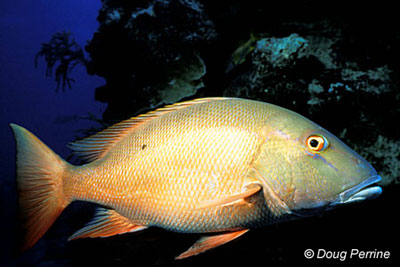
Lutjanus analis
This snapper has an almond-shaped body and pointed fins, including a crescent tail fin. They are olive on top, with red tint on their sides and underside, as well as distinct markings like the spot on the upper side and blue lines on their cheeks. At rest they display paler bars across their backs which become solid color when they are swimming. They are solitary off-shore dwellers who prefer rocky ruble and reefs, yet the juveniles find in-shore grass beds to hide in.
Order: Perciformes
Family: Lutjanidae
Genus: Lutjanus
Species: analis
Common Names
English common names include mutton snapper, mutton fish, king snapper, virgin snapper, and snapper. Other common names include ariocó, caranho, caranho-vermelho, cioba, sioba, and vermelho-de-fundo (Portuguese); carde clair, oreille noire, sorbe, and vivaneau sorbe (French); lucjan muton (Polish), pargo, pargo cebado, pargo cebal, pargo colorado, pargo criollo, pargo mulato, and sama (Spanish); schnapper (German).
Importance to Humans
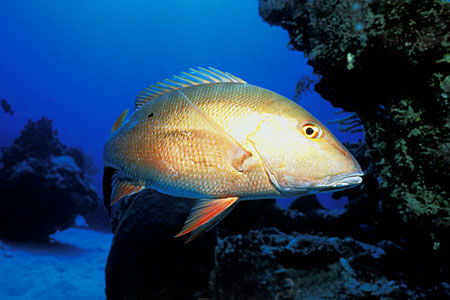
The mutton snapper is a popular game and an exceptionally good quality food fish. The flesh is marketed fresh as well as frozen and often labeled as “red snapper”. These fish battle hard and can be a very challenging game fish. At one time, they comprised the majority of the commercial snapper catch. However, recently their populations have decreased resulting in a decline in commercial fisheries. Main methods of capture include boat seines, gill nets, and bottom longlines, handlines, traps, and spearfishing. This snapper has not been linked to ciguatera poisoning.
Conservation Status
> Check the status of the mutton snapper at the IUCN website.
The IUCN is a global union of states, governmental agencies, and non-governmental organizations in a partnership that assesses the conservation status of species.
Geographical Distribution
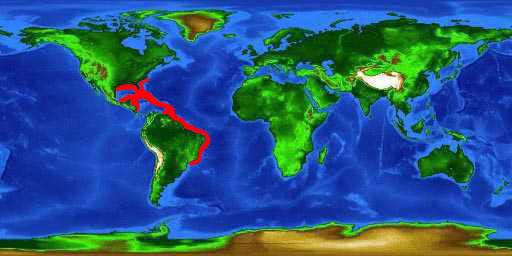
The mutton snapper is found in the western Atlantic Ocean from Massachusetts to Brazil, but is most common in the tropical waters of Florida, the Bahamas, and the Caribbean Sea. It is also found in the Gulf of Mexico.
Habitat
Large adults are found in or near offshore reef and rock rubble habitats, while the juveniles live in inshore areas. The juveniles are abundant in shallow waters such as tidal mangrove creeks, canals, and shallow protected bays, utilizing turtle grass as bottom cover. Solitary adults can be found among rocks and reefs, while juveniles occur over sandy or sea grass bottoms. Once an adult mutton snapper becomes established in an area, they tend to remain there. Small aggregations of mutton snapper may form during the day, disbanding at night. These fish may be found at depths ranging from 80 – 310 feet (25-95 m).
Biology
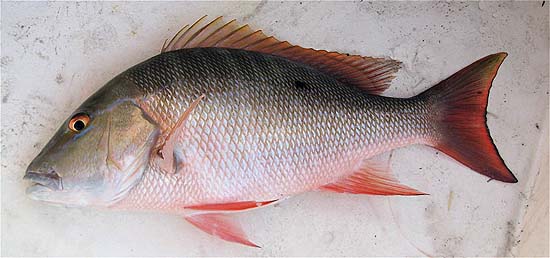
Distinctive Features
This snapper is a relatively deep-bodied fish, with an almost lunate-shaped tail. It has a moderately bi-lobed dorsal fin, and a sharply pointed anal fin. The pectoral fin of this snapper is long, reaching just past the anal origin.
Coloration
Mutton snappers are very colorful, with olive green on their backs and upper sides and a red tinge on the lower sides and undersides. There is a distinct black spot on the upper back and blue stripes on the cheek region below the eye. There are two color phases, barred which is seen when the fish is resting and plain color seen when the fish is swimming. The anal fin is pointed and there is a small black spot below the dorsal fin. They are sometimes confused with the lane snapper (L. synagris), but the lane snapper has yellow pelvic fins and a round anal fin while all of the mutton snapper’s fins are red and the anal fin is pointed. The caudal fin margin is black.
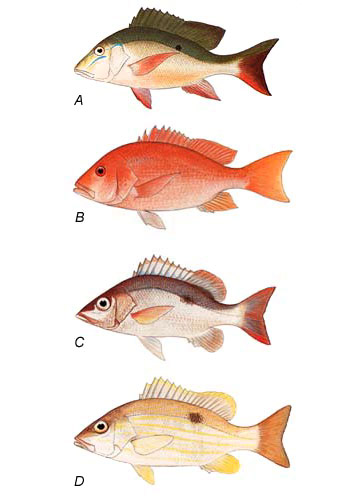
Dentition
The relatively small teeth of the mutton snapper are similar in both jaws. On the upper jaw there is a v-shaped vomerine tooth patch which has small sharp teeth used to hold prey.
Size, Age, and Growth
The mutton snapper has an average length of 20 inches (50 cm), with a maximum length of 34.8 inches (88.5 cm) total length. They are sexually mature at about 16 inches (40 cm) in length. They can weigh up to 10 or 15 pounds (4.5-6.8 kg). The maximum age of this snapper is up to 40 years. The average lengths of fish from one scientific study showed that the mutton snapper ranges from 6.3 inches (16.1 cm) at one year of age to 30.6 inches (77.8 cm) at 14 years of age.
Food Habits
The feeding habits of the mutton snapper change during their life history. Larval snappers feed on plankton near the surface of the water. As they settle out into the shallow grass beds, they begin to feed on larger plankton and small invertebrates. The diet then switches to shrimp, snails, crabs, and small fish such including mullet and small grunts.
The primary feed behavior of this species is “picking” at food items during the entire day. Midwater strikes occurred during the morning and evening hours. Body coloration is dependent upon feeding mode, with dark barred color patterns associated with feeding along the bottom substrate while there was no change in coloration during midwater feeding.
Reproduction
This snapper spawns throughout its range, though primarily in the northeastern Caribbean. They form large, transient aggregations while spawning. Spawning occurs during the month of February in the Caribbean region while in other areas spawning occurs during summer. Mutton snapper exhibit high site-fidelity, spawning at the same site and the same lunar calendar days, year after year. All snappers are oviparous; they release pelagic eggs that move freely with the water currents. The number of eggs is dependent upon the size of the female. After spawning, the adult fish move offshore to deeper waters.
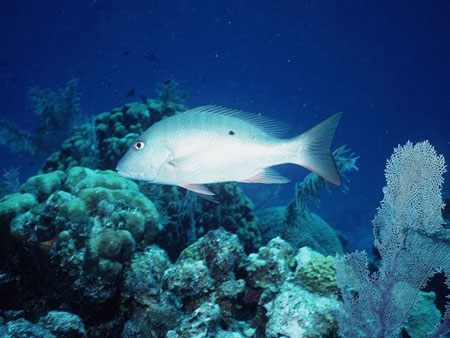
At lengths of less than 10 mm, the larvae tend to be planktonic. There is little known about the development of the larvae. They eventually settle on suitable habitat that offers some protection from predators. Juveniles have been described as having green/brown lateral bands and transparent fins at lengths of 15mm. At 22mm in length, juveniles have thin yellow lateral stripes and a dorsolateral spot.Predators
Natural predators of mutton snapper include large predatory fishes, including other snappers and sharks.
Taxonomy
Lutjanus analis was first described by Georges Cuvier in 1828 from a Hispanolan specimen. Synonyms include Mesoprion sobra Cuvier, 1828, Mesoprion isodon Valenciennes, 1829, and Mesoprion rosaceus Poey, 1870.
Prepared by: Rebecca Murray and Cathleen Bester